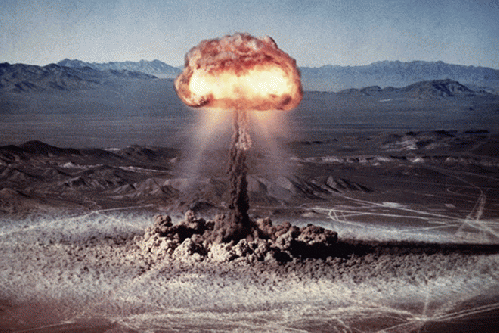Easy_Buster_ cropped.jpg by Google Images US Government
America's Tar Baby
Problem solved: Why not detonate a series of small nuclear bombs underneath the bituminous tar sands in northern Alberta to vaporize the rock and create large caverns into which the heavy crude oil, now heated and separated from much of its surrounding sand, would naturally drain for easy drilling and extraction?
Preposterous as it now might sound, this proposal by a Richfield Oil geologist, L.M. Natland, and strongly supported by Edward Teller and numerous high-ranking American proponents of "peaceful" uses of atomic energy, was seriously discussed at the highest levels of the Canadian government between 1958 and 1962. Project Cauldron, or as it was subsequently renamed for better public consumption, Project Oilsand, was actually approved in April 1959 by the Canadian Federal Mines Department with the initial explosion planned for a remote Alberta test site.
Though growing public anxiety in Canada about radiation danger and the threat of nuclear war led to the project's cancellation in the early 1960s, it retained enough support among oil-sands developers to resurface a decade later. A patent was granted for what was described as "The Process for Stimulating Petroliferous Subterranean Formations with Contained Nuclear Explosions," but once again, despite support from an aptly named Canadian Oil company, Phoenix Oil, the project failed to gain sufficient political traction and was abandoned.
Like the mythical bird itself, the idea of using nuclear power in the tar sands has taken flight once again in our own era, though this time disguised as a Green Energy solution. While public and political attention has been focused on the controversial XL Pipeline and, more recently, on the potentially catastrophic global climate impact of mining and ultimately burning the vast amount of fossilized carbon stored in the Athabascan deposits, beneath the radar, the search for cheaper and more efficient methods of extracting the oil from the soil has continued unabated.
Visible environmental damage from open-pit mining of the oil-bearing sands has led to increasingly significant political backlash in both Canada and the United States. Alternative techniques of tapping the deeper reserves, estimated at between 80% and 90% of the potential oil available, requires deep wells, extensive energy supplies, and the infusion of vast amounts of heated water or steam to liquefy the oil, separate it from surrounding structures, and pump it to the surface. It is in service of this costly process that the latest incarnation of what was once called the 'friendly atom' has reappeared.
An expert panel created by the Alberta government in 2009 reported that existing oil-sands projects required one billion cubic feet of natural gas daily, a figure that was projected to grow rapidly in future years. Thus, when an attractive 'new' nuclear energy supply calling for the installation of two to four 1,000-megawatt reactors was publicly floated by Bruce Power, supported by the Canada West Foundation, a public policy-research group supporting the concept of "the expansion/development of nuclear power in Alberta and Saskatchewan," it met with great interest among drilling advocates.
Environmental and anti-nuclear groups quickly raised concerns about hidden costs such as water contamination and the dangers of long-term spent-fuel storage created by this supposedly 'clean energy' technique. Pointing out that only 5% to 10% of the enormous amount of water required to produce the oil could be safely returned to the environment, one writer pointed out that the rest would have to be held in tailing ponds indefinitely because of its toxicity.
Another critic, journalist and author Andrew Nikiforuk, ironically observed that: "The first country to use nuclear power to produce fossil fuel will not be highly regarded on the planet."
Yet the world's largest known deposits of bitumen, estimated to match the planet's total proven reserves of conventional petroleum, continue to be too tempting for developers to ignore. Powerful corporations such as Toshiba (builder of the Fukushima Daiichi 3 power plant), Bruce Power, one of Ontario's largest nuclear power operators, and its parent company, Cameco, one of the largest suppliers of uranium in the world, among others, are outspoken advocates for what's been renamed "Green Bitumen."
As reported in January 2013, despite last year's Fukushima disaster and the recent German decision to end all use of nuclear energy, current plans being discussed in Canada now call for the installation of Toshiba's new version of "mini" nuclear reactors in the Canadian north, with estimated deployment scheduled for 2020. As envisioned, the initial project would include an underground reactor building with an earthquake-absorbing structure capable of withstanding the region's enormous temperature extremes.
For more than a half-century, Canadian and American interests have shared the singular goal of developing and marketing Tar Sands oil using any and all available technologies. Yet, if climatologist James Hansen's recent calculations that the tar sands contain as much as half of the carbon needed to raise planetary temperatures past the 2-degree-Celsius threshold required to trigger runaway climate change are factored into the equation, those interests cannot be allowed to determine our choices.
Having avoided the madness of 'attacking' the tar sands with nuclear weapons, can we now allow ourselves to be seduced into substituting so-called 'peaceful' nuclear power, only to produce planetary results which are, if anything, more threatening to global well-being? In the words of Dr. Warren Bell, founding president of the Canadian Association of Physicians for the Environment, linking nuclear power to tar sands development offers only the false hope that "the putative 'greenness' of the former will counteract the overwhelming 'blackness'" of the latter.
We are, indeed, trapped between the atom and the deep, dark sands, only this time with the additional awareness that our success in extricating ourselves from this increasingly 'sticky' problem may well prove to be critical for the future of the entire planet.





